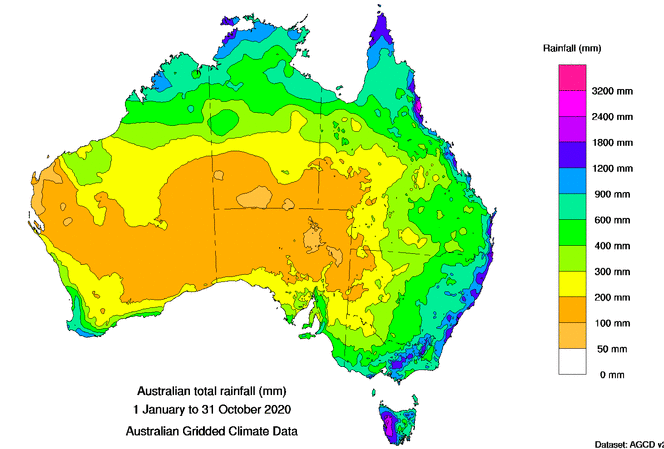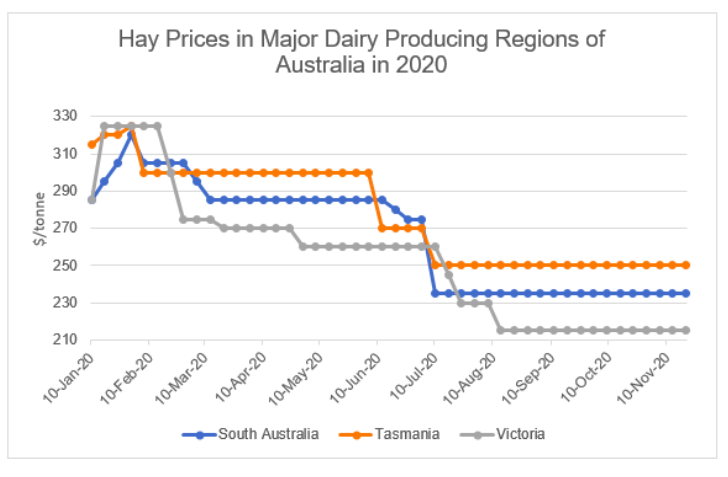Australian milk production has a positive outlook for 2021
Australia witnessed severe drought conditions in 2018 and 2019 due to which the milk production of the country fell flat. However, in mid-2020, milk-producing regions in the country experienced drought-breaking rainfall which brings hope for the turnaround of the dairy industry. As rainfalls commenced, the fodder production increased and the dairy producers started benefiting from the increased availability of fodder at lower prices. The dip in the prices along with adequate and good quality fodder will enable the farmers to achieve higher yield per cow and improve the overall milk production. The rebound is most likely to flow into 2021, with milk production forecasted at 9.4M MT which is 2% more than the 2020 estimate of 9.2M MT and a 4% increase over the 2019 drought-impacted production of 8.8M MT.
Tasmania recorded an increase of approximately 6% in January to September 2020 period (YTD) compared to the same period in 2019. Following Tasmania, South Australia similarly had an increase of roughly 5% and Victoria with an improvement of 2%. Queensland was the only region which recorded a fall in the milk production. The region not only witnessed drought conditions in the past few months but a large number of dairy farmers in the region exited the business.

The positive outlook for 2020 and 2021 is due to the following reasons:
Drought-breaking rains commenced in early 2020
- The primary influence on the milk production estimate for 2020 and the further forecast improvement in 2021 is the improved rainfall across most of the dairy-producing regions in the first half of 2020.
- 81% of the milk is produced in South Australia, New South Wales and Victoria. The regions experienced heavy rainfall in comparison to the same periods in 2018 and 2019. Average rainfall of 168 mm was recorded in South Australia till 1st November 2020 which is 54% more than the rain recorded (in mm) during the same period in 2019. New South Wales recorded an increase of 59% and Victoria recorded a 29% increase during the same period.
- The dairy regions in Queensland, Tasmania, and Western Australia in January to September 2020 period also saw improvement in rainfall compared to the same periods in 2018 and 2019. The improvement was not as high as in South Australia, New South Wales and Victoria but the drought conditions did improve. The highest increase of 31% in rainfall was seen in Western Australia 2020 followed by Tasmania 23% and Queensland with a merge increase of 2%.

Source:Australian Government, Bureau of Meteorology (2019)

Source: Australian Government, Bureau of Meteorology (2020)
- With above-average rains in the majority of the dairy-producing regions, farmers are in a position to replenish hay and silage reserves in the spring season of 2020. The reserves are enough to satisfy the needs and demand even during 2021.
- Dairy farmers are slowly gaining confidence that they have adequate and good quality fodder reserves which will last till 2021, enabling them to achieve higher yield per cow and overall milk production through at least early 2021.
Bumper grain crop and lower grain prices in the second half of 2020
- During the second half of 2020, dairy producers have benefited from reduced feeding costs. Hay and grain prices started to decline in comparison to the soaring prices at the start of 2020.
- In the peak drought season of 2019, hay prices reached levels above the five-year average. There was very scarce pasture growth which resulted in a shortage of fodder to balance the requirements of the dairy producer.
- Commencement of the rains in the region pushed the pasture production to normal levels. The prices started to fall as fodder supply rebounded to its normal levels. The price of hay started to fall from the peak in May and dipped to the lowest levels by July and August. The fodder production is expected to increase in future given the positive rain forecasts further pushing down the prices and making quality fodder accessible to the farmers.

- The highest hay price in 2020 was recorded on 31st January at AUD 320 per MT in South Australia. The lowest price was recorded on 10th July right after the drought-breaking rains. The price fell by 26% and dipped to AUD 235 per MT.Similarly, the prices peaked in Tasmania in January touching AUD 325 per MT. By July the prices dipped to AUD 230 per MT which is approximately a 29% fall in the hay prices. Hay prices in Victoria recorded a high of AUD 320 per MT in February and dipped to AUD 215 per MT in August 2020. The region witnessed a 33% fall in hay prices during this period.
Sources
Australian Government. “Bureau of Meteorology"
Dairy Australia. “Hay Report”
Dairy Australia. “Milk Production Report”
Farm Online. “Australian milk production forecast to increase: Situation and Outlook report”
